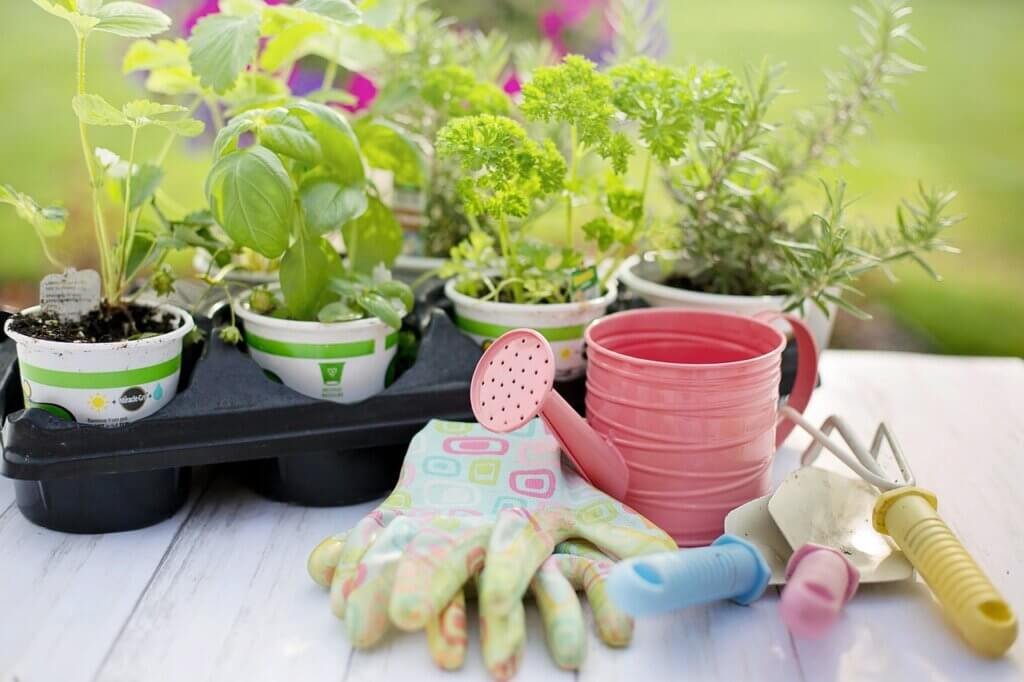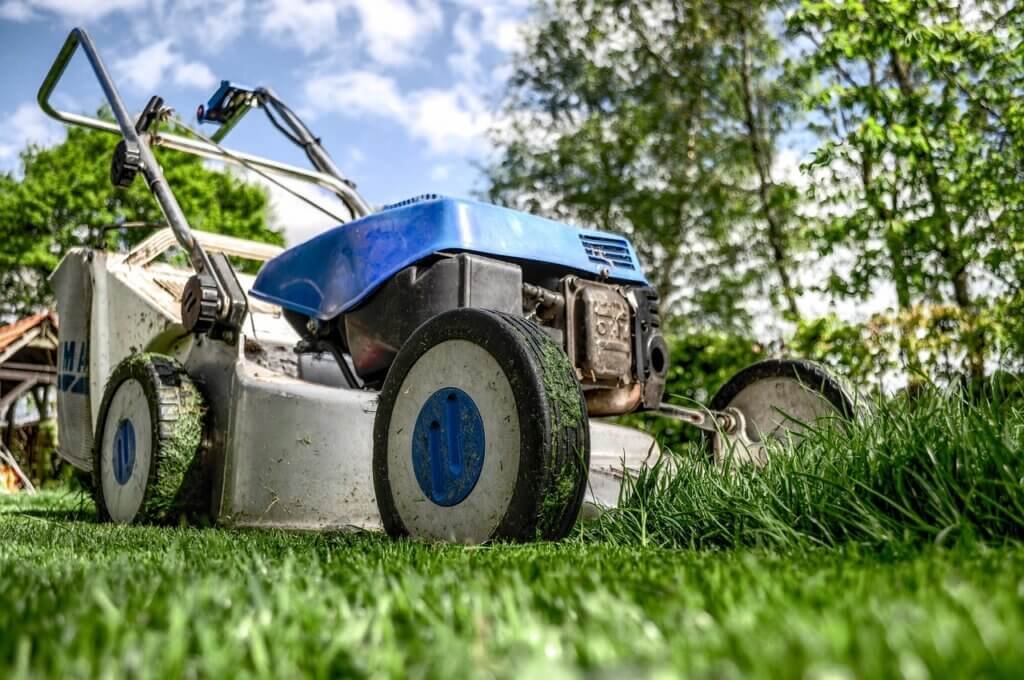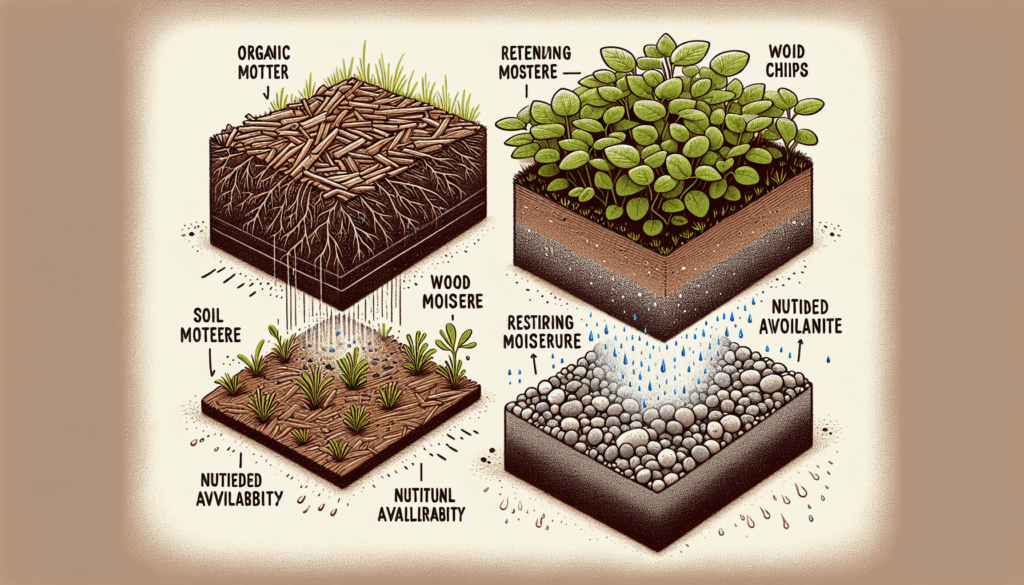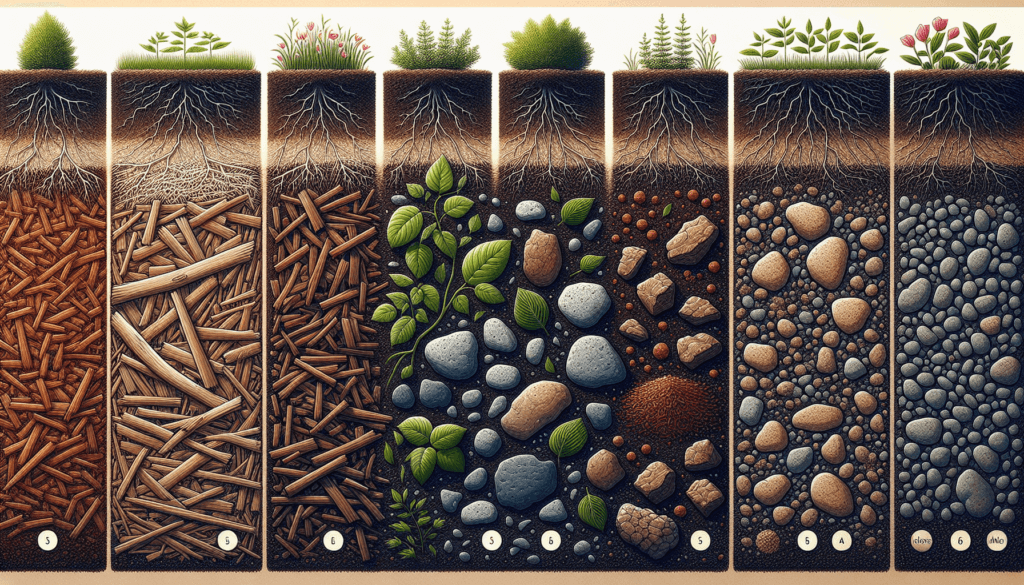Mulch is a simple yet powerful tool that can significantly enhance the health of your soil. By creating a protective layer over the ground, mulch acts as a natural blanket, shielding the soil from extreme temperatures, retaining moisture, and blocking weed growth. Not only does mulch improve the overall structure of the soil, but it also provides nutrition as it breaks down over time. From organic options like wood chips and straw to inorganic choices like gravel or rubber, there are various mulch materials to suit your needs. Discover how incorporating mulch into your gardening routine can transform your soil into a thriving foundation for healthy plants.

Benefits of using mulch
Retaining soil moisture
Using mulch in your garden can help retain soil moisture by acting as a barrier between the soil and the air. It helps to prevent water evaporation, keeping the soil moist and reducing the need for frequent watering. This is particularly beneficial in dry or arid climates where water conservation is important.
Controlling weed growth
Mulch acts as a natural weed suppressant by inhibiting weed seeds from germinating and competing with your plants for nutrients and water. It forms a physical barrier that prevents sunlight from reaching the soil, which effectively limits weed growth. This reduces the time and effort required for weeding, allowing you to spend more time enjoying your garden.
Preventing soil erosion
Mulch plays a crucial role in preventing soil erosion caused by heavy rain or strong winds. It acts as a protective layer, keeping the soil in place and preventing it from being washed away. This is especially important on sloping landscapes or areas susceptible to erosion, as it helps to maintain the integrity of the soil and prevent nutrient loss.
Improving soil fertility
Another benefit of using mulch is its ability to improve soil fertility. As the mulch breaks down over time, it releases organic matter into the soil, enriching it with essential nutrients and enhancing its fertility. This promotes healthy plant growth and ensures that your garden thrives.
Regulating soil temperature
Mulch acts as a natural insulator, helping to regulate soil temperature. It keeps the soil cool during hot summer months by blocking the sun’s rays and reducing evaporation. In colder climates, it acts as a protective layer, insulating the soil and preventing it from freezing or experiencing extreme temperature fluctuations. This creates a more stable environment for plants to grow, ensuring their overall health and vitality.
Enhancing microbial activity
Mulch provides a beneficial environment for soil microbes, fungi, and other microorganisms. These organisms thrive in the moist, nutrient-rich environment created by the mulch. They break down organic matter, converting it into essential nutrients that plants can readily absorb. This enhances overall soil health and promotes a thriving ecosystem beneath the surface.
Suppressing soil-borne diseases
Certain types of mulch, such as wood chips or straw, have natural antimicrobial properties that can help suppress soil-borne diseases. They contain compounds that can inhibit the growth of harmful pathogens, reducing the risk of diseases affecting your plants. This is particularly important in vegetable gardens, where soil-borne diseases can quickly spread and affect crop yields.
Promoting nutrient cycling
Mulch acts as a natural catalyst for nutrient cycling in the soil. As it breaks down, it releases nutrients back into the soil, making them available for plants to use. This promotes a sustainable and self-sufficient ecosystem where nutrients are recycled and utilized efficiently, reducing the need for synthetic fertilizers.
Encouraging earthworm activity
Earthworms play a vital role in improving soil health by aerating the soil and enhancing nutrient availability. Mulch provides a favorable environment for earthworms, attracting them to your garden and promoting their activity. Their burrowing and feeding habits help to improve soil structure, increasing its fertility and drainage capabilities.
Reducing soil compaction
Mulch helps to prevent soil compaction by acting as a cushioning layer between the ground and heavy foot traffic or machinery. It absorbs the impact and distributes the pressure, minimizing the risk of soil compaction. This is especially important in areas where there is regular traffic or in compacted soils, as it allows for better root penetration and overall plant health.
Types of mulch
Organic mulch
Organic mulch is made from natural materials such as bark chips, straw, leaves, compost, or wood chips. It provides numerous benefits to the soil and plants and is an excellent choice for improving soil health.
Inorganic mulch
Inorganic mulch includes materials such as stones, gravel, plastic sheeting, or rubber mulch. While it doesn’t provide the same nutrient benefits as organic mulch, it is often used for specific purposes such as weed control or aesthetic appeal.
Living mulch
Living mulch refers to the use of low-growing plants that act as a ground cover while providing similar benefits to traditional mulch. These plants, such as clover or creeping thyme, help retain moisture, suppress weeds, and improve soil health.

Organic mulch
Benefits of organic mulch
Organic mulch offers a wide range of benefits to your garden. Besides retaining moisture, controlling weeds, preventing soil erosion, improving fertility, regulating temperature, enhancing microbial activity, suppressing diseases, promoting nutrient cycling, encouraging earthworm activity, and reducing soil compaction, organic mulch also adds organic matter to the soil as it breaks down, further improving its structure and fertility.
Common types of organic mulch
Some common types of organic mulch include wood chips, straw, shredded leaves, compost, and grass clippings. These materials are readily available and provide excellent coverage and benefits to your garden.
Application tips for organic mulch
When applying organic mulch, make sure to spread it evenly and maintain a thickness of 2-4 inches. Avoid piling it up against the base of plants, as this can create a moist environment that promotes rot and pest infestations. Regularly replenish the mulch as it breaks down to maintain its effectiveness and appearance.
Inorganic mulch
Benefits of inorganic mulch
Inorganic mulch offers its own set of benefits, although it may not provide the same level of soil improvement as organic mulch. It is long-lasting, does not break down or decompose, and can provide effective weed control or aesthetic appeal to your garden.
Common types of inorganic mulch
Examples of inorganic mulch include gravel, stones, plastic sheeting, or rubber mulch. These materials are durable and can be used in areas where organic mulch may not be suitable, such as around structures or in high-traffic areas.
Application tips for inorganic mulch
When using inorganic mulch, make sure to properly prepare the soil by removing any existing weeds or debris. Apply a layer of landscape fabric beneath the mulch to further suppress weed growth. Ensure that the mulch is evenly spread and not too deep to allow for proper water penetration and air circulation.

Living mulch
Benefits of living mulch
Living mulch offers the benefits of traditional mulch while also providing additional benefits such as attracting beneficial insects, providing habitat for beneficial organisms, and creating a visually appealing ground cover. It can enhance biodiversity in your garden and contribute to a more sustainable and self-sufficient ecosystem.
Examples of living mulch
Common examples of living mulch include low-growing plants like clover, thyme, or creeping phlox. These plants can be planted in between rows of crops or as a ground cover in flower beds, providing the same benefits of mulch while adding a touch of beauty to your garden.
Considerations when using living mulch
When using living mulch, it is essential to choose plants that are compatible with your main crops and are capable of withstanding foot traffic or other activities in the garden. Regular maintenance, such as trimming and pruning, may be required to keep the living mulch in check and prevent it from overpowering or shading out other plants.
How to properly apply mulch
Preparing the soil
Before applying mulch, it is crucial to prepare the soil by removing weeds, rocks, or debris. Loosen the soil to ensure proper water penetration and nutrient uptake by the plants. It is also recommended to amend the soil with organic matter or compost to improve its fertility before mulching.
Choosing the right mulch
Consider the specific needs of your garden when selecting mulch. Organic mulch is a great option for improving soil health, while inorganic mulch may be more suitable for specific purposes like weed control or aesthetic appeal. Take into account factors such as climate, plant types, and personal preferences when making your selection.
Calculating the amount of mulch needed
To determine the amount of mulch needed, measure the square footage of the area to be mulched and multiply it by the desired depth. A general rule of thumb is to apply mulch at a depth of 2-4 inches. This calculation will help ensure you purchase the correct amount and avoid excessive or insufficient mulch coverage.
Applying mulch on different soil types
When applying mulch, consider the specific needs of your soil type. Sandy soils, for example, may require a thicker layer of mulch to retain moisture, while clay soils may benefit from a thinner layer to allow for better drainage. Adjust the thickness of the mulch accordingly to suit your soil conditions.
Avoiding common mulching mistakes
To get the most out of mulch, avoid common mistakes such as piling mulch against the base of plants, using mulch too close to stems or tree trunks, or allowing the mulch to become excessively compacted. These mistakes can lead to the development of rot, pest infestations, or other detrimental effects. Properly apply mulch with care to ensure the health and well-being of your plants.

Best practices for mulch maintenance
Refreshing mulch layers
Over time, organic mulch will break down and decompose, losing its effectiveness. Regularly refresh the mulch layer by adding a new layer on top. This will ensure that the soil continues to receive the benefits of mulch, such as moisture retention and weed control.
Weeding beneath the mulch
While mulch helps to suppress weed growth, it is still important to regularly check for and remove any weeds that may emerge beneath the mulch layer. This will prevent them from competing with your plants for nutrients and ensure a healthy growing environment.
Monitoring moisture levels
Keep an eye on the moisture levels in your garden, particularly during hot, dry periods. Mulch helps to retain moisture, but it is important to ensure that the soil does not become too soggy or waterlogged. Use proper watering techniques to maintain the ideal balance of moisture for your plants.
Avoiding excessive mulch depth
While mulch is beneficial, it is important to avoid applying it too thickly. Excessive depth can hinder water penetration and air circulation, leading to the development of fungal diseases or root rot. Stick to the recommended thickness of 2-4 inches to maximize the benefits without causing harm.
Dealing with pests and diseases
Regularly inspect your mulch for signs of pests or diseases. Certain types of mulch, such as wood chips, can attract termites or other wood-boring insects. Address any issues promptly to prevent infestations or the spread of diseases. Proper mulch maintenance and hygiene are key to maintaining a healthy garden environment.
Mulching for specific purposes
Mulching for trees and shrubs
When mulching around trees and shrubs, create a donut-shaped mulch ring around the base of the plant, leaving a small space around the trunk. Avoid piling mulch directly against the bark, as this can promote rot or pest infestations. Apply mulch at a 2-4 inch thickness, extending it to the drip line of the plant to provide optimal moisture retention and weed control.
Mulching for vegetable gardens
In vegetable gardens, mulch plays an essential role in moisture retention, weed suppression, and maintaining optimal soil temperature. Apply a thick layer of mulch, such as straw or shredded leaves, around your vegetable plants, leaving space around the stems to prevent rot. Regularly replenish the mulch to ensure its effectiveness throughout the growing season.
Mulching for flower beds
When mulching flower beds, consider the specific needs of your plants. Organic mulch, such as compost or wood chips, can provide an added aesthetic appeal, while also promoting soil fertility and moisture retention. Apply a layer of mulch around the base of your flowers, maintaining a thickness of 2-4 inches, and avoid piling it against the stems.
Mulching for pathways and walkways
Mulching pathways and walkways can provide a visually appealing and practical solution. Use materials such as gravel, stones, or wood chips to create a durable and functional surface. The mulch will prevent weeds from growing through, minimize soil erosion, and create a defined walking area in your garden.

Mulching in different climates
Mulching in hot and arid climates
In hot and arid climates, mulching is particularly important for soil moisture retention. Use a thick layer of organic mulch, such as wood chips or straw, to provide insulation and reduce water evaporation. Water your plants deeply before applying mulch to ensure the moisture is locked in, and regularly monitor the soil to prevent excessive dryness or water stress.
Mulching in cold and snowy climates
Mulching in cold and snowy climates can provide insulation and protection for plants during harsh winters. Choose a thick and durable mulch, such as straw or bark chips, to create a protective layer over the soil. Mulch should be applied after the ground has frozen to prevent rodents from nesting in it. Remove excessive snow buildup from the mulch to prevent smothering or damage to plants.
Mulching in humid and tropical climates
In humid and tropical climates, mulching is important for moisture retention and weed suppression. Organic mulch, such as compost or shredded leaves, can help create a favorable microclimate for plants in these regions. However, it is important to ensure proper air circulation and avoid excessive mulch thickness to prevent the development of fungal diseases in the humid environment.
Overcoming common challenges
Dealing with weeds in mulch
While mulch helps suppress weed growth, some stubborn weeds may still emerge. Regularly inspect your mulch for any weeds and remove them promptly to prevent them from establishing and spreading. Applying a layer of landscape fabric beneath the mulch can provide additional weed control.
Preventing fungus growth in mulch
Fungal diseases can occasionally develop in organic mulch, especially in warm and humid climates. To prevent fungus growth, avoid overwatering, ensure proper air circulation, and regularly turn or fluff the mulch to expose it to sunlight. If fungus is present, consider removing the affected mulch and replacing it with fresh material.
Avoiding detrimental effects of excessive mulch
Applying excessive mulch can have negative consequences for your plants. It can lead to oxygen deprivation of roots, root rot, or the attraction of pests. Stick to the recommended mulch thickness of 2-4 inches, ensuring proper air circulation and water drainage to maintain a healthy growing environment.
Addressing mulch surface compaction
Over time, mulch may become compacted, inhibiting water penetration and air circulation. Regularly fluff or turn the mulch to prevent surface compaction. Aerate the mulch layer using a garden fork or rake to promote better water and air movement, ensuring the continued health of your plants.
Overall, using mulch in your garden provides numerous benefits for improving soil health. It helps retain soil moisture, control weed growth, prevent soil erosion, improve fertility, regulate temperature, enhance microbial activity, suppress diseases, promote nutrient cycling, encourage earthworm activity, and reduce soil compaction. By understanding the different types of mulch, properly applying and maintaining it, and considering specific purposes and climates, you can ensure the success and vitality of your garden. Take advantage of mulch’s potential and enjoy the many advantages it brings to your gardening journey.


